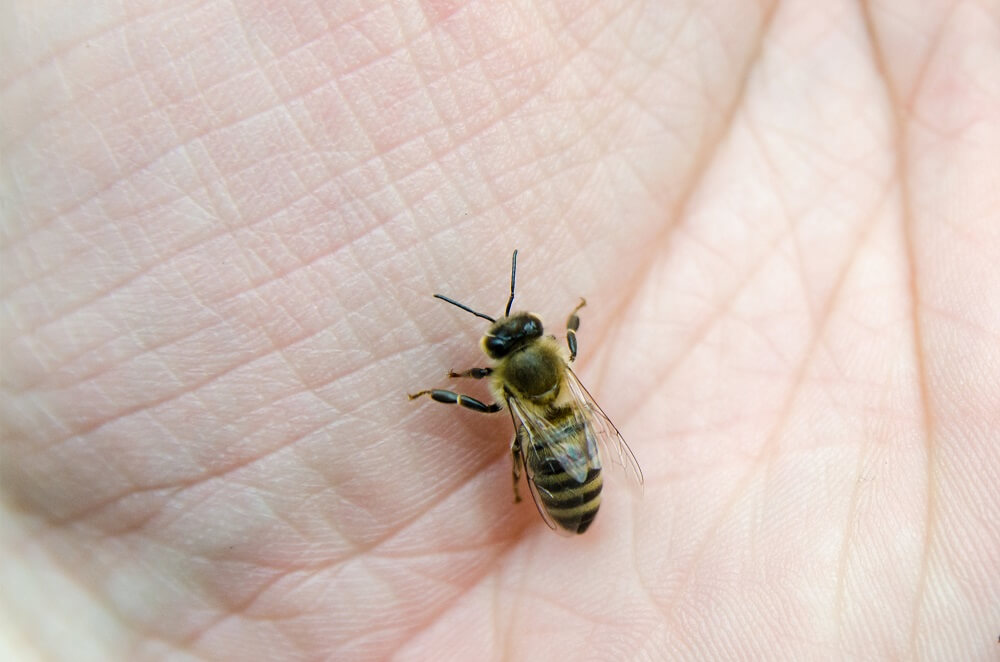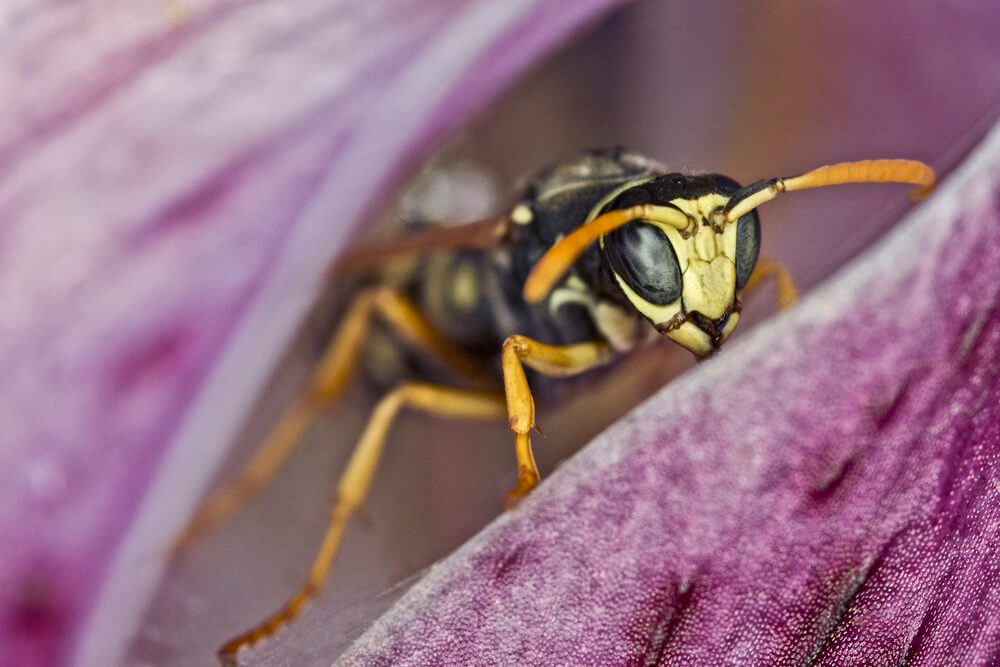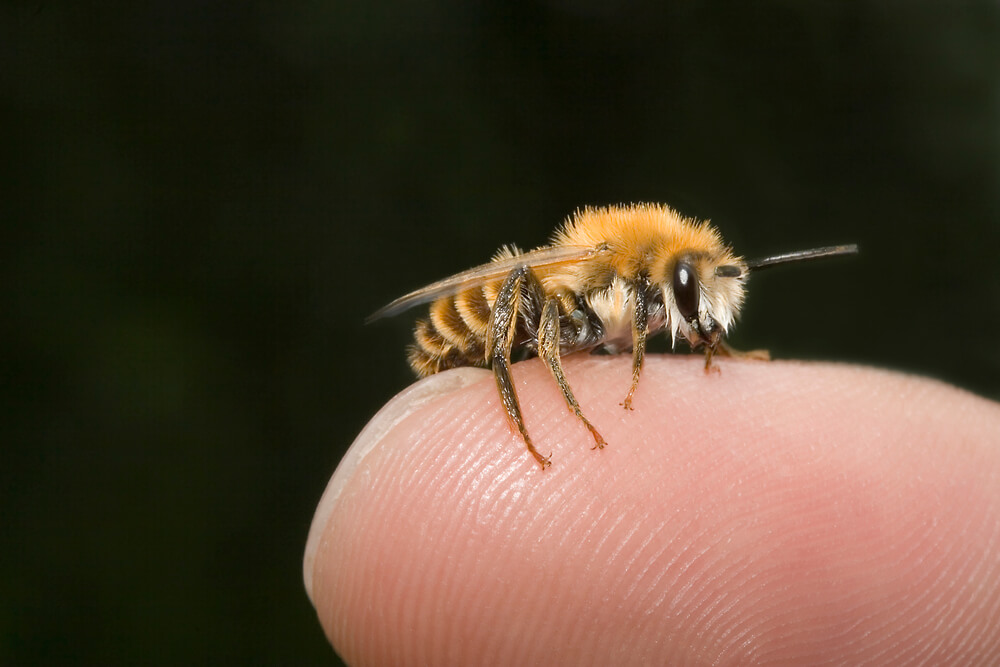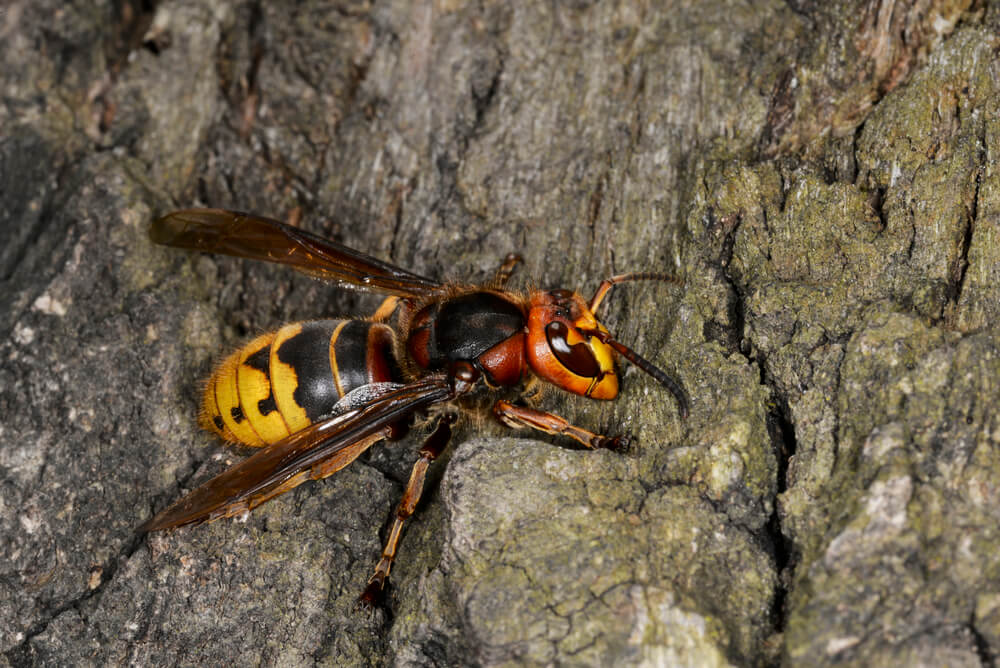Table of Contents:
How to Remove a Bee Stinger Stuck Under Skin

The best way to remove a stubborn bee stinger is to soak it in Epsom salt or cover it with a baking soda paste.
For the baking soda method, mix baking soda with warm water until it forms a paste-like consistency. Apply the paste to the sting site area and cover it with a bandage overnight.
We recommend using bandages like these for extra grip and breathability.
After several hours, the baking soda paste should help the stinger work its way closer to the surface of your skin. Next, you can grab a flat object, like a debit card, to gently scrape across the stinger to remove it entirely.
Baking soda has antibacterial properties that can help reduce swelling, itching, and redness.(1, 2)
For the Epsom salt method, mix one-part Epsom salt with one-part warm water. Soak the area for 30 minutes at least three times per day.
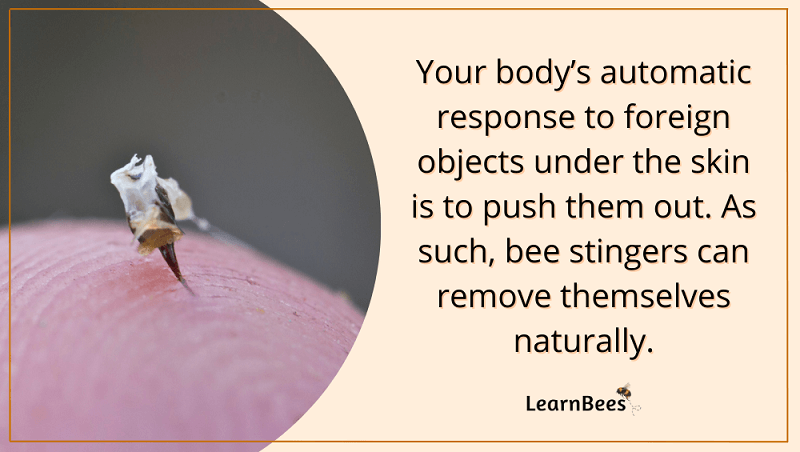
Your body’s automatic response to foreign objects under the skin is to push them out. Soaking the stinger in Epsom salt should further speed up this process. Once the stinger has worked its way to the skin’s surface, use a flat object to scrape it out gently.(3)
Bee stingers look like tiny, black dots beneath the skin’s surface.
Keep in mind:
Only honey bees leave their stingers behind in the skin.
Other bee species and wasps don’t lose their stingers after stinging. So if you were stung by a bumble bee or yellowjacket, for example, then you won’t have to worry about removing the stinger.
Once the stinger is removed:
Keep the sting site area cleansed thoroughly with antibacterial soap and water.
We recommend cleansing the area twice daily and applying a topical treatment such as calamine lotion or hydrocortisone cream to reduce inflammation.(4, 5)
What Happens if You Can’t Get a Bee Stinger Out?
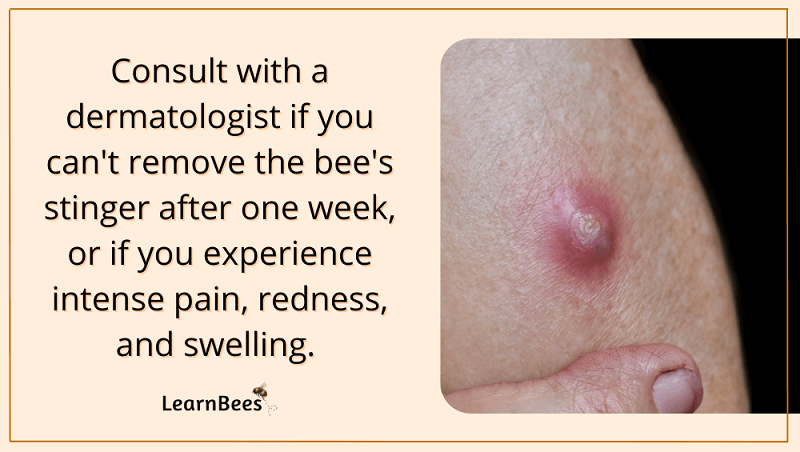
Leaving a bee stinger in can lead to excess irritation and redness. However, your body’s natural response will be to push the stinger out, so you might find that this occurs after a few days.(6, 7)
Monitor the area to ensure the redness, swelling, and pain don’t worsen.
Itching is a normal symptom for a few days after a bee sting. Applying calamine lotion or hydrocortisone cream can help with these symptoms.
As mentioned:
It’s essential to wash the area with soap and water at least twice daily. This will keep the area clean and potentially ward off infection. If the bee stinger is left in the skin for a week or more, then it’s best to visit a dermatologist for help with removal.
Dermatologists are medical doctors that specialize in the skin. They regularly offer treatment for bee and wasp stings.(8)
If you experience hives, dizziness, difficulty breathing, or a sudden drop in blood pressure, you must seek medical attention immediately. This is known as anaphylaxis and is a life-threatening allergic reaction.(9, 10)
How Do You Know if a Bee Stinger Is Still in You?
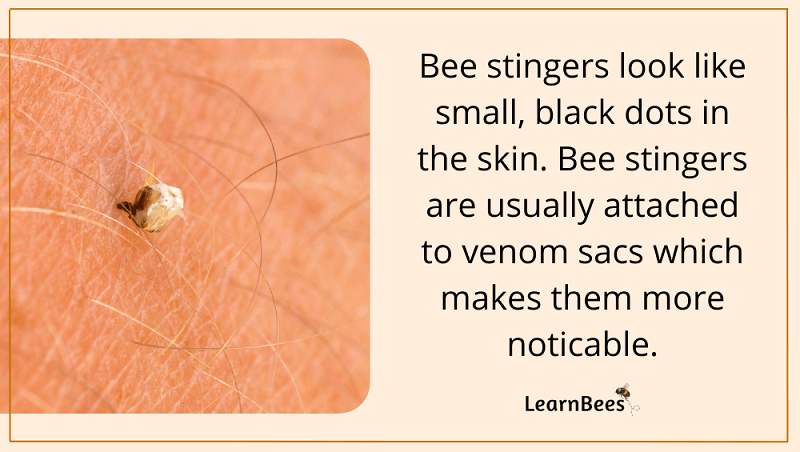
Bee stingers look like tiny, black dots underneath the skin. Often, the bee stinger will still be attached to the venom sac. The venom sac has a bulbous end.
If you don’t see a black dot, then the stinger has likely worked its way out. It’s not unusual for the stinger to come out on its own because the body’s normal reaction is to push out foreign objects.
If you’re unsure if the bee stinger is still in you, try looking at the area under a magnifying glass in bright lighting.
You can also soak the area in Epsom salt or apply a baking soda paste. These solutions will help further draw the bee stinger out. Additionally, they can help reduce inflammation.
But remember:
Don’t panic if a bee stinger is stuck under the skin.
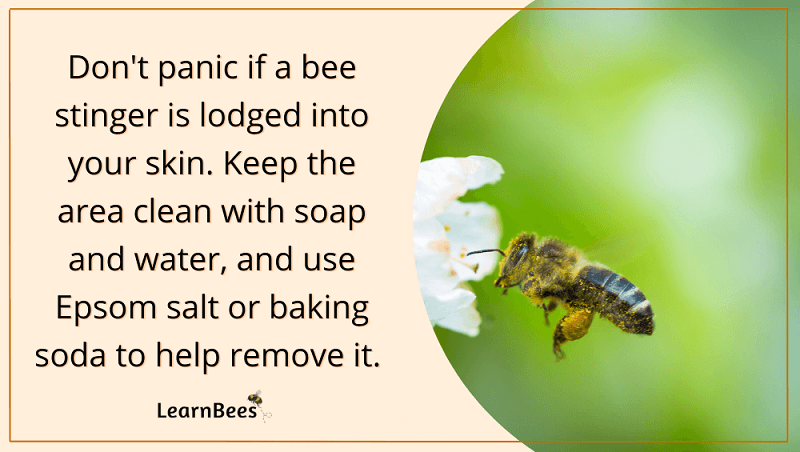
Bee stings are relatively common during the warmer months. Most people experience mild reactions that subside within a few hours. Fewer than five percent of adults experience severe reactions to bee stings. Children are even less likely to experience severe reactions.(11, 12)
If the redness, swelling, and pain worsen after a few days, then it’s best to visit your doctor or dermatologist for treatment.
Bee stings may cause a sharp, burning pain which will typically subside within four to six hours. After the pain has subsided, it’s normal to experience slight swelling, redness, and itching at the sting site area.
At-home topicals such as calamine lotion or hydrocortisone cream can help reduce inflammation. To prevent infection, washing the area with soap and water at least twice a day is imperative.(4, 5)
Seek medical treatment if you experience any of the following symptoms after a bee sting:
- Hives
- Faintness
- Shortness of breath
- Troubled breathing
- Drop in blood pressure
- Rapid heartbeat
FAQs on How to Remove a Bee Stinger Stuck Under Skin
- Will a bee stinger come out by itself?
- Should you squeeze the stinger until it comes out?
- Will baking soda draw out a bee stinger?
- Will Epsom salt draw out a bee stinger?
- Will peroxide remove a stinger?
- Why does vinegar help bee stings?
- Will toothpaste help a bee sting?
- Can a bee sting cause a hard lump?
- When should you go to the doctor for a bee sting?
- What does a bee stinger look like when it comes out?
- What does an infected bee sting look like?
- How long can a stinger still inject venom?
- Do bee stings get worse the next day?
- What happens if a bee stinger stays in your skin?
- How do you remove an embedded bee stinger?
Will a bee stinger come out by itself?
Yes, the bee stinger can come out by itself. The body naturally expels foreign objects, so it’s possible that the stinger can work its way out on its own.
—> Go back to the FAQs on bee stinger stuck under skin
More to Explore:
Should you squeeze the stinger until it comes out?
No, you should avoid squeezing the stinger. Squeezing the stinger can cause more venom to be released and make the reaction worse. Instead, gently scrape the area around the stinger with your fingernail or a credit card. This can help pull out the stinger.
—> Go back to the FAQs on bee stinger stuck under skin
More to Explore:
Will baking soda draw out a bee stinger?
Yes, baking soda can be used to draw out a bee stinger.
Mix together equal parts of baking soda and water until it forms a paste. Apply the paste directly onto the affected area. Leave it on overnight or for a few hours, then wash it off. Repeat this process until the stinger has come out.
—> Go back to the FAQs on bee stinger stuck under skin
More to Explore:
Will Epsom salt draw out a bee stinger?
Yes, Epsom salt can help draw out a bee stinger stuck under the skin.
Mix one-part Epsom salt with one-part water. Either soak the area directly in the solution or soak a cotton ball in the solution and apply it to the sting site for at least 30 minutes. Soak the area up to three times daily until the stinger is removed.
—> Go back to the FAQs on bee stinger stuck under skin
More to Explore:
Will peroxide remove a stinger?
Hydrogen peroxide is not the best treatment for removing a bee stinger. Instead, use either baking soda or Epsom salt.
—> Go back to the FAQs on bee stinger stuck under skin
More to Explore:
Why does vinegar help bee stings?
Vinegar can help reduce itching and inflammation from bee stings. It also helps neutralize the stinger’s venom, leading to a faster recovery.
—> Go back to the FAQs on bee stinger stuck under skin
More to Explore:
Will toothpaste help a bee sting?
There is anecdotal evidence suggesting that toothpaste can help a bee sting. To try it, apply a small amount of toothpaste directly onto the affected area. Leave it on overnight and then wash it off in the morning.
—> Go back to the FAQs on bee stinger stuck under skin
More to Explore:
Can a bee sting cause a hard lump?
Bee stings can cause a hard lump that is painful or tender to the touch. This usually happens when the bee stinger is left in the skin for a prolonged period. It can also happen if the bee sting site gets infected and develops pus.
If this occurs, seek medical attention immediately.
—> Go back to the FAQs on bee stinger stuck under skin
More to Explore:
- What’s the Difference Between Wasps, Hornets, and Bees?
- Wasp Nest vs. Bee Nest: Which One Is It?
- Wasps vs. Honey Bees: Are They Different?
When should you go to the doctor for a bee sting?
You should seek medical attention if you experience severe swelling or pain that lasts longer than 24 hours. Additionally, seek medical care immediately if you experience hives, faintness, troubled breathing, or rapid heartbeat.
While rare, it’s possible to experience anaphylactic shock from a bee sting, so it’s essential to seek medical care if you experience any of the above symptoms. In such cases, doctors typically prescribe an EpiPen to treat the reaction.
—> Go back to the FAQs on bee stinger stuck under skin
More to Explore:
What does a bee stinger look like when it comes out?
Bee stingers look like small, black objects when you remove them from the skin. They can have a similar appearance to splinters, except they’re usually darker in color.
—> Go back to the FAQs on bee stinger stuck under skin
More to Explore:
What does an infected bee sting look like?
Infected bee stings tend to have excess redness and swelling. You may also experience pus.
Additionally, there will typically be increased pain, with the sting site area becoming more sensitive to the touch.
It’s best to consult with a doctor if you experience those symptoms. Doctors can remove the stinger from your skin and prescribe medication if necessary. Bee stings are common during the warm months, so doctors are well-equipped to handle them.
—> Go back to the FAQs on bee stinger stuck under skin
More to Explore:
How long can a stinger still inject venom?
If left in the skin, stingers can inject venom for several minutes after the initial sting.
—> Go back to the FAQs on bee stinger stuck under skin
Do bee stings get worse the next day?
Bee stings can get worse the next day for people experiencing moderate reactions. Itching, slight redness, and swelling are normal reactions.
However, most people experience mild reactions to bee stings that subside within four to six hours.
—> Go back to the FAQs on bee stinger stuck under skin
What happens if a bee stinger stays in your skin?
People often ask:
What happens if a stinger is not removed? What happens if a bee stinger stays in your skin for a week?
The answer is that bee stingers can often work their way out of your skin on their own. However, it’s best to keep the area clean with soap and water to help prevent infection. It’s also recommended to see a dermatologist if the stinger remains in your skin for more than a week.
—> Go back to the FAQs on bee stinger stuck under skin
How do you remove an embedded bee stinger? What draws a stinger out?
The best way to remove an embedded bee stinger is to use either baking soda or Epsom salt. These solutions will help bring the stinger to the skin’s surface.
